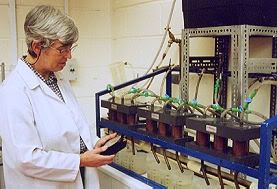Pre-Mixed Chemicals.
The chemicals needed for hydroponic plant growth are now being mixed in the correct proportions. These mixtures may be obtained through catalogs, or from garden-supply stores and reputable fertilizer suppliers. They are relatively inexpensive, and small quantities will go a long way in growing plants. Follow the directions on the container.
Self-Mixed Chemicals.
You may want to prepare your own nutrient solution. The nutrient solution given below was worked out by the late Dr. D. R. Hoagland of the University of California. This solution supplies the major elements required for plant growth. It is easy to prepare, and usually gives satisfactory results.
Zinc sulfate and copper sulfate usually do not need to be added because of their presence as impurities in the water and in the other chemical compounds used in making up a nutrient solution. If you use the water-culture method of growing plants, it may be necessary to add the iron solution once or twice a week. You may want to use the chelated form of iron, since this form will not readily precipitate out of the solution. Mix one and one-half ounces of NaFe EEDTA 13 percent Fe2 O3 in 5 quarts of water.
Use one-fourth pint of this solution in 25 gallons of water. Other sources of nutrients may be substituted for those in the tables as long as they furnish the mineral nutrients needed by the plants. The toxic effects of some chemicals upon plant growth must always be considered when making substitutions.
After all of the chemicals have been mixed into the solution, check the pH (acidity or alkalinity) of the solution on a pH scale. The pH scale runs from 0 to 14. Any solution below 7.0 is acid, and any solution above 7.0 is basic or alkaline. A pH of 7.0 is neutral.
Plants that do well at a low pH (between 4.5 and 5.5) include azaleas, buttercups, gardenias, and roses. Plants that will grow at a pH level between 7.0 and 7.5 include potatoes, zinnias, pumpkins, and myrtle. Usually plants will not grow with any success in solutions below a pH of 4.0 or above a pH of 8.0. For most plants, the solution should be slightly acid within a range of 5.5 to 6.5.
Use an indicator or pH tester to determine the pH of the solution. Indicator papers register pH within different ranges. When dipped into the solution, the paper will change color at different pH levels. There are other devices for determining pH, and testing kits may be obtained from scientific and chemical supply houses.
If the pH is above the desired range, it can be brought down by adding dilute sulfuric acid. Add the acid in very small quantities, stirring the solution at the same time. An eye dropper is useful for this purpose. Count the drops. After a few drops have been added, retest the solution.
Continue adding acid and retesting until the solution reaches the desired pH range. If you count the drops of acid, you can put the same number of drops into the solution each time the solution is made up. You will not need to make further pH tests as long as the water and chemicals of the solution remain unchanged.
Mixed Chemicals
7:39 AM
ThanateTan







